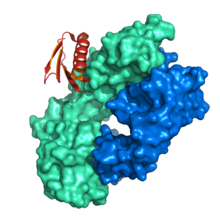Protein L
| Protein L b1 domain | |||||||||
|---|---|---|---|---|---|---|---|---|---|

Structure of protein L binding to the light light chain of a murine Fab.
|
|||||||||
| Identifiers | |||||||||
| Symbol | PpL | ||||||||
| Pfam | PF02246 | ||||||||
| InterPro | IPR003147 | ||||||||
| SCOP | 1MHH | ||||||||
| SUPERFAMILY | 1MHH | ||||||||
|
|||||||||
| Available protein structures: | |
|---|---|
| Pfam | structures |
| PDB | RCSB PDB; PDBe; PDBj |
| PDBsum | structure summary |
Protein L was first isolated from the surface of bacterial species and was found to bind immunoglobulins through L chain interaction, from which the name was suggested. It consists of 719 amino acid residues. The molecular weight of Protein L purified from the cell walls of was first estimated as 95kD by SDS-PAGE in the presence of reducing agent 2-mercaptoethanol, while the molecular weight was determined to 76kD by gel chromotography in the presence of 6 M guanidine HCl. Protein L does not contain any interchain disulfide loops, nor does it consist of disulfide-linked subunits. It was an acidic molecule with a PI of 4.0. Unlike Protein A and Protein G, which bind to the Fc region of immunoglobulins (antibodies), Protein L binds antibodies through light chain interactions. Since no part of the heavy chain is involved in the binding interaction, Protein L binds a wider range of antibody classes than Protein A or G. Protein L binds to representatives of all antibody classes, including IgG, IgM, IgA, IgE and IgD. Single chain variable fragments (scFv) and Fab fragments also bind to Protein L.
Despite this wide binding range, Protein L is not a universal antibody-binding protein. Protein L binding is restricted to those antibodies that contain kappa light chains. In humans and mice, most antibody molecules contain kappa (κ) light chains and the remainder have lambda (λ) light chains. Protein L is only effective in binding certain subtypes of kappa light chains. For example, it binds human VκI, VκIII and VκIV subtypes but does not bind the VκII subtype. Binding of mouse immunoglobulins is restricted to those having VκI light chains.
Given these specific requirements for effective binding, the main application for immobilized Protein L is purification of monoclonal antibodies from ascites or cell culture supernatant that are known to have the kappa light chain. Protein L is extremely useful for purification of VLκ-containing monoclonal antibodies from culture supernatant because it does not bind bovine immunoglobilins, which are often present in the media as a serum supplement. Also, Protein L does not interfere with the antigen-binding site of the antibody, making it useful for immunoprecipitation assays, even using IgM.
...
Wikipedia
